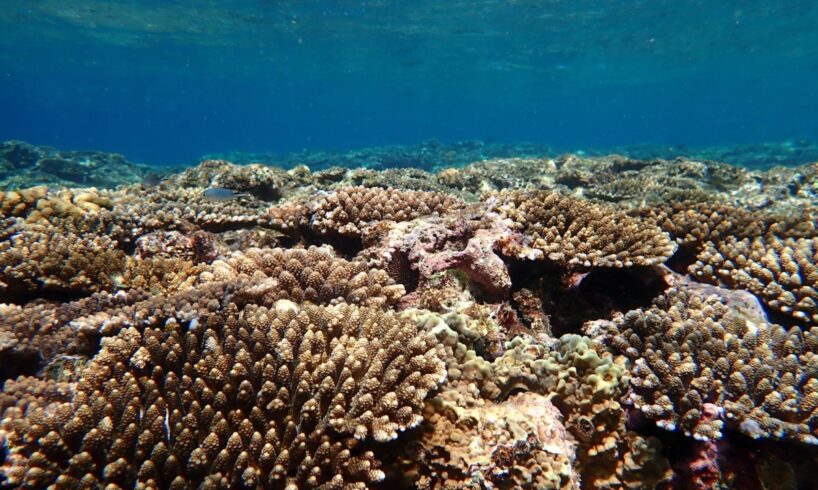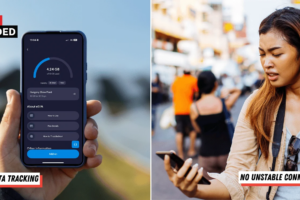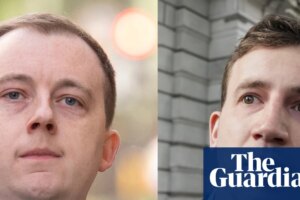
If you’re heading to Hawaii or another tropical destination abroad this summer, you may notice something unusual about the sunscreen on offer at the local pharmacy.
With some jurisdictions choosing to ban certain sunscreens in the name of protecting marine life, more products are being rolled out with “reef-safe” and “ocean-friendly” claims.
While some bans have been in place for several years, the debate over just how harmful these products are is far from settled.
Japan doesn’t have any such regulations in place. But Japanese cosmetic giants, whose sunscreens are proving to be immensely popular among foreign consumers looking for lightweight textures, are not entirely immune from the controversy.
On one side are marine conservationists, environmentalists and some tourism authorities, who argue that a growing body of research linking certain sunscreen ingredients to coral bleaching is enough to take preventive action.
On the other side, cosmetics companies and some scientists say the health benefits of sunscreen, especially in preventing skin cancer, must be weighed against the potential risk to marine life. They also argue that the level of risk that sunscreen poses to coral is minor compared to the broader threat of climate change and warming oceans.
Regulatory moves
Amid growing awareness of the importance of skin care, demand for sunscreen is on the rise worldwide. According to Fortune Business Insights, the global sun care market was valued at $14.9 billion in 2024, a figure that is projected to grow to $15.5 billion in 2025 and reach $22.3 billion by 2032.
Most sunscreens are made from a mix of UV filters, which either absorb or scatter UV rays, as well as chemicals such as stabilizers, fragrances and preservatives.
Sunbathers apply sunscreen at a beach in Sydney in April. Amid a debate over sunscreen regulations, some say that bans on ingredients that are hard to find alternatives for may restrict access to effective tools against skin disease.
| Reuters
In recent years, the potential harm caused by chemicals such as oxybenzone and octinoxate when they wash off the bodies of beachgoers and pollute the ocean has attracted significant attention, leading some jurisdictions to ban them. Instead, those jurisdictions recommend the use of “mineral” sunscreen, which typically contains zinc oxide and titanium dioxide and is seen as less toxic to the environment.
Palau, a Pacific island nation that relies heavily on tourism, led the way by introducing the world’s first sunscreen regulations in 2020, banning 10 common ingredients.
Hawaii followed suit in 2021, with the U.S. state banning the sale and distribution of any sunscreen containing oxybenzone or octinoxate. Beyond the state-level rules, Maui and the island of Hawaii have adopted stricter regulations, banning any sunscreen that uses an active ingredient other than titanium dioxide and zinc oxide.
Similar bans on specific ingredients have been introduced in the U.S. Virgin Islands, parts of Mexico and within Thailand’s marine national parks.
Japanese authorities allow sunscreens sold and used in the country to contain oxybenzone and octinoxate as long as they are within certain limits.
In Palau, discussions within the country’s government began after the local Coral Reef Research Foundation published a report in 2017 about Jellyfish Lake, says Orion Cruz, a Washington-based attorney who helped draft Palau’s sunscreen regulations. The lake, a World Heritage site, is a popular tourist destination where visitors can swim alongside a swarm of harmless, orange jellyfish.
The report highlighted the presence of several sunscreen chemicals in the tissue of jellyfish, as well as a recent decline in the jellyfish population, he says.
“The report did not conclude that the sunscreen chemicals caused that collapse, but they expressed some concern because they found the chemicals in such high concentrations,” Cruz says, noting that the report gave impetus to the adoption of sunscreen regulations in the country.
Bleached corals off Thailand’s Trat province in May 2024. While bleached corals don’t die immediately, they lose the nutrients provided by algae, and eventually die if bleaching continues.
| Reuters
Cruz says that, before enacting the Responsible Tourism Education Act of 2018, the country’s government consulted numerous scientists, including Craig Downs, an ecotoxicologist at Haereticus Environmental Laboratory known for his longtime research on sunscreen pollution.
A 2022 opinion paper co-written by Cruz and Downs outlined the harm that sunscreen pollution can cause to marine and freshwater ecosystems, and the need for governments to inspire industry innovations for safer products.
“Sunscreen pollution can be a symptom of unsustainable tourism and coastal development, impacting marine and aquatic resources,” they wrote, adding that it can impact primary production and hurt the viability of offspring.
Cruz says that the regulations are “precautionary” and flexible enough, as they allow chemicals scientifically proven to be harmless to the environment or human health to be removed from the list.
In addition to the initial ban of 10 specific ingredients, Palau now bans their derivatives, which are slightly different chemicals in the same classes as the outlawed ones. The government confiscates all sunscreens deemed to be toxic to reefs from tourists upon entry, and retailers selling them can be fined.
Industry response
The series of regulatory moves has rattled the cosmetics industry, which broadly views the current bans as not backed by sufficient scientific evidence.
The U.S. Personal Care Products Council, a powerful trade group for the cosmetics industry, has released statements opposing the bans, advocating instead for “sound scientific research in policymaking to ensure consumer access to safe, effective sunscreens.”
“Hawaii’s legislation banning oxybenzone and octinoxate in sunscreens has raised concerns over the lack of scientific evidence linking sunscreen ingredients to coral reef decline, with other environmental factors like climate change and pollution identified as more significant contributors,” the group says on its website.
Tokyo-based Kao, a major cosmetic company that develops and markets sunscreen products, says that the company has complied with regulations in each region and has launched a nonchemical product as well.
But Kenkichi Fujii, vice president of regulatory science with the global brand, recalls that the industry was “stunned” when debate on sunscreen regulations arose in Hawaii around 2018.
Kao is a member of the U.S. council as well as similar trade organizations in Japan and Europe.
“It is true that vacationers and sunbathers use sunscreens, which are shed into the ocean,” Fujii says, stressing that the firm’s stance is in line with other global makers. “But they become diluted as they are carried by the waves. So even though their concentrations may increase momentarily, they go down over time.”
Coral reefs repeat the bleaching and recovery process according to seasonal changes in ocean temperatures, he says, noting that climate change and a warming ocean are most strongly associated with bleaching, which is happening earlier in the year around the world.
“Our basic stance is that we still have doubts about whether sunscreens cause coral bleaching,” he says. “We would like to understand the reasoning behind these regulations accurately, explain to consumers the position of our products based on this understanding, and develop products that can be explained from such a position.”
Shiseido and Kao are among the Japanese brands that have had to navigate changing regulations over sunscreen amid environmental concerns.
| Reuters
Shiseido, another major Japanese cosmetic brand, also says that the sunscreens it markets in Hawaii are in compliance with local rules and do not contain banned ingredients. It doesn’t sell sunscreen in Palau.
“Shiseido not only complies with safety assurance guidelines and laws and regulations around the world, but has also established its own strict safety assurance standards to confirm the safety of all ingredients in its products and formulate them appropriately,” a spokesperson said.
Others are raising concerns about the impact of anti-sunscreen messaging on human health.
Kao’s Fujii points to the vital role sunscreens have played in preventing severe sunburns and skin cancer, saying that bans on common ingredients that are hard to find alternatives for may restrict access to effective tools against a major public health threat.
Compound effects
Many Japanese cosmetics companies are conducting independent research to examine the toxicity of sunscreen ingredients on corals. Last year, Kao published findings of a joint study with the University of Tokyo in the journal Science of the Total Environment.
In the study, the team exposed a coral species called Acropora tenuis collected from the reef off Sesoko Island in Okinawa to oxybenzone for 96 hours. All of the coral fragments were dead at the 24-hour mark when the chemical’s concentration was 5.6 milligrams per liter, but none died at lower concentrations. Based on the results, the concentration that had harmful effects to 50% of the test corals — a benchmark used in toxicity tests — was calculated to be 2.0 mg per liter, more than 1,000 times the highest concentration reported in a 2013 study that sampled actual seawater in Okinawa. Also, through RNA sequencing, they found that corals showed different “gene expression” patterns when responding to higher ocean temperatures and to higher concentrations of oxybenzone.
“Corals themselves know the difference between heat stress and chemical stress, which I found to be very interesting,” says Toshiyuki Takagi, a coral researcher at the University of Tokyo who was involved in the study. “At present, we cannot tell from looking at corals what has caused their bleaching, but we may be able to develop a method to identify the cause from gene expression.”
Toshiyuki Takagi, a coral researcher at the University of Tokyo’s Atmosphere and Ocean Research Institute, looks over corals cultured at the institute in Kashiwa, Chiba Prefecture, earlier this month.
| Tomoko Otake
Yutaka Tashiro, a professor at Meio University in Okinawa Prefecture, conducted a sampling survey of ocean water at an Okinawa beach in the early 2010s. His team’s conclusion at the time was that, while concentrations of sunscreen chemicals varied by location, time of day and the number of people, they were not high enough to have a clear impact on coral or other marine life, he says.
But the negative impact of sunscreen cannot be entirely ruled out, given the increasingly harsh conditions for coral reefs, which are bearing the brunt of climate change, he says.
Coral reefs provide food, shelter and spawning grounds for many marine species. They are called the “rainforests of the sea” due to their ability to support abundant life.
Coral bleaching is a phenomenon in which corals drive out the symbiotic algae living inside their tissues. While bleached corals don’t die immediately, they lose the nutrients provided by such algae, and eventually die if bleaching continues.
“Corals can be reborn or nurtured after bleaching,” Tashiro says. “One big concern is that chemical pollution (including that brought on by sunscreens) may hinder this recovery process.”
Tashiro adds that mineral sunscreens — some of which use nanoparticles to remove a noticeable white cast with them — haven’t proven to be completely safe for the environment, either. “Now, researchers (worldwide) are studying how zinc oxide and titanium dioxide impact the environment and organisms,” he says. “It’s probably less gray than chemical sunscreens, but no definitive conclusion has been drawn.”
While research on the environmental impact of sunscreens has been limited in Japan, some institutes affiliated with municipal governments have recently started analyzing water quality in the ocean and rivers, says Yutaka Kameda, an environmental chemistry professor at the Chiba Institute of Technology.
His team also started sampling surveys of waters off an Okinawa beach last year in partnership with researchers from the National Institute of Advanced Industrial Science and Technology. He echoes Tashiro’s view that the impact of chronic chemical stress on corals remains unclear at this point.
Unlike industry representatives, however, Kameda considers moves by Hawaii to target oxybenzone and octinoxate “reasonable,” citing a growing number of studies on their toxicity and endocrine-disrupting quality, mostly to humans.
Meanwhile, some products with “reef-friendly” labeling have recently come under heavy scrutiny. In March, the Santa Clara County District Attorney’s Office in California sued the maker of the Hawaiian Tropic and Banana Boat sunscreens, saying it engaged in false advertising by calling some of its products “reef-friendly” without scientific support.
In March, the Santa Clara County District Attorney’s Office in California sued the maker of the Hawaiian Tropic and Banana Boat sunscreens, saying it engaged in false advertising by calling some of its products “reef-friendly” without scientific support.
| Reuters
The Australian Competition and Consumer Commission also sued the owner of the popular sunscreens for alleged greenwashing last month. The consumer watchdog alleges that, while the sunscreens do not contain oxybenzone or octinoxate, they contain other ingredients that either cause or risk causing harm to coral and marine life, such as octocrylene and homosalate.
While there are no easy answers, Tashiro says the best approach to protecting yourself from the sun varies among people. Those engaged in outdoor work, whether in construction or marine tourism, should do everything they can to protect themselves from UV rays, including by using sunscreens, he says. For others, seeking shade and covering their bodies with breathable, long-sleeved shirts, as well as hats and sunglasses, would be a viable option.
“The idea that reducing exposure to the sun and wearing protective clothing is an environmentally friendly option should spread more widely,” he says.





